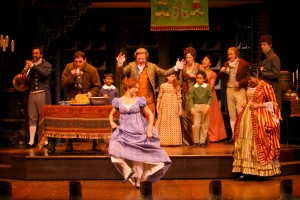A CAROL FOR THE PAST, PRESENT, AND FUTURE
The Goodman Theatre is the custodian of the most popular tradition in Chicagoland holiday entertainment, Charles Dickens’ A Christmas Carol. The 2011 production does not depart in any major way from the 33 previous presentations (excluding a disastrous revival many years ago that turned the story into a circus). There may be a few tweaks in the staging, but attending the 2011 revival will be like visiting an old friend. It’s the same irresistible blend of Victorian sentimentality, fantasy, preaching, and realism.
The current edition retains the fine Tom Creamer adaptation, which veteran audiences can almost recite by memory. Everyone on stage is colorfully outfitted in vivid and authentic mid-Victorian costumes by Heidi Sue McMath, the dances and carols are (presumably) authentically nineteenth century, and the cries for social justice and sympathy for the poor and the outcast are Dickensian to the core. A Christmas Carol remains a sacred trust for this theater and revisionists need not apply. Some past Goodman productions have displayed more spectacle and special effects, or had more music, but the play remains the thing. I doubt we will ever see the show presented in modern dress, or with Scrooge played by a woman, on a Goodman stage.
 Any presentation of the play takes its coloring from how the leading actor interprets Scrooge. Larry Yando is back for his fourth shot at the role, and he is obviously having great fun with the part. In the opening scenes Yando’s Scrooge is the nastiest of curmudgeons. By the end of the story, when Ebenezer has seen the error of his ways and turns into a good guy, Yando cavorts around the stage in joyous glee. But there is still subtlety in his acting. Near the end, Scrooge visits his nephew Fred and announces in both embarrassment and hope that he has accepted Fred’s invitation to Christmas dinner. It’s a genuinely moving moment and says as much about Scrooge’s conversion from miser to humanitarian as all the character’s previous laughing and dancing about.
Any presentation of the play takes its coloring from how the leading actor interprets Scrooge. Larry Yando is back for his fourth shot at the role, and he is obviously having great fun with the part. In the opening scenes Yando’s Scrooge is the nastiest of curmudgeons. By the end of the story, when Ebenezer has seen the error of his ways and turns into a good guy, Yando cavorts around the stage in joyous glee. But there is still subtlety in his acting. Near the end, Scrooge visits his nephew Fred and announces in both embarrassment and hope that he has accepted Fred’s invitation to Christmas dinner. It’s a genuinely moving moment and says as much about Scrooge’s conversion from miser to humanitarian as all the character’s previous laughing and dancing about.
The production is Goodman’s gift to the Chicagoland acting community, employing almost 30 actors and musicians during a time when most theaters are dark until after the New Year. In the spirit of the story’s plea for tolerance, the production once again is strongly interracial and multi-ethnic. Bob Cratchit’s wife is African American and their little boy Tiny Tim is Asian. Yet this casting, which might jar the spectator in another context, perfectly suits the spirit of this show.
 The supporting cast is a mix of new faces and veterans of the Chicago stage, like Lisa Tejero (Mrs. Crumb), Ross Lehman (Fezziwig), and Karen Janes Wooditsch (Mrs. Cratchit). First among equals for the fifth straight year is Ron Rains as Bob Cratchit; Rains takes a role that could easily drown in bathos and turns Cratchit into a warm and decent human being. His weeping over the death of Tiny Tim is sincere and unaffected and for the fifth straight year brought a lump to my throat. The acting honors list should also include Elizabeth Ledo as the perky Ghost of Christmas Past and Joe Minoso as Scrooge’s nephew.
The supporting cast is a mix of new faces and veterans of the Chicago stage, like Lisa Tejero (Mrs. Crumb), Ross Lehman (Fezziwig), and Karen Janes Wooditsch (Mrs. Cratchit). First among equals for the fifth straight year is Ron Rains as Bob Cratchit; Rains takes a role that could easily drown in bathos and turns Cratchit into a warm and decent human being. His weeping over the death of Tiny Tim is sincere and unaffected and for the fifth straight year brought a lump to my throat. The acting honors list should also include Elizabeth Ledo as the perky Ghost of Christmas Past and Joe Minoso as Scrooge’s nephew.
Steve Scott directs with an appropriate respect for the show as a holiday icon. The physical production is dominated by Todd Rosenthal’s large architectural rolling sets that put the action in Scrooge’s bedroom, his office, and elsewhere in London. Complementing the sets are Robert Christen’s lighting design and Richard Woodbury’s sound design. Andrew Hansen composed the original music performed with great skill by four onstage musicians.
I saw the show at a weekday evening performance in an audience heavily populated with children. Several of the very youngest viewers couldn’t make it through the entire two-hour evening, but I didn’t heard a disruptive whine from any of the kiddies and adolescents in the crowd, the ultimate tribute to the spell Dickens’s morality tale/ghost story has cast for almost 170 years.
photos by Dean La Praire and Eric Y. Exit
A Christmas Carol
Goodman Theatre
ends on December 31, 2011
for tickets, visit Goodman
for more shows, visit Theatre in Chicago



